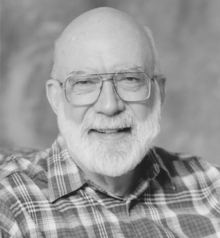Michael Harner
Michael Harner | |
|---|---|
 | |
| Born | April 27, 1929 |
| Died | February 3, 2018 (aged 88) |
| Occupation(s) | Anthropologist, educator and author |
Michael James Harner (April 27, 1929 – February 3, 2018) was an American anthropologist, educator and author. His 1980 book, The Way of the Shaman: a Guide to Power and Healing, He also founded the Foundation for Shamanic Studies.
Career
Harner was born in Washington, D.C. in 1929.
In 1960-61 he reported experimenting with the Amazonian plant medicine
In 1966, having taught at UC-Berkeley and served as associate director of the Lowie Museum of Anthropology, Harner became a visiting professor at
In 1983, Harner founded the Center for Shamanic Studies, which is today known as the Foundation for Shamanic Studies.
He died on February 3, 2018, at the age of 88.[11]
Development of Core shamanism
After traveling to the Amazon where he reported ingesting the hallucinogen ayahuasca, Harner began experimenting with monotonous drumming. In the early 1970s he started giving training workshops to small groups in Connecticut. In 1979 he founded the Center for Shamanic Studies in Norwalk, Connecticut.
In 1980, Harner published The Way of the Shaman: a Guide to Power and Healing,
Students in the United States and Europe began to take his classes in what he was now calling "core shamanism"[14] (as differenced from traditional, Evenk shamanism, or other Indigenous, ethnic and historical practices that have been referred to as "shamanism" in anthropological texts). Most authors in the field, especially Harner's critics, consider Harner's core shamanism to be the primary influence on, and foundation of, the Neoshamanic movement.[2][15][13][16]
Harner later integrated his Center for Shamanic Studies into the nonprofit Foundation for Shamanic Studies. The Foundation received financial support primarily from the Core Shamanism courses and workshops he taught, supplemented by private donations. From the early 1980s onward, he invited a few of his students to join an international faculty to reach an ever-wider market. In 1987, Harner resigned his professorship to devote himself full-time to the work of the foundation.[17] He largely ceased publishing, except for occasional articles in the publication "Shamanism."[18][19]
See also
Bibliography
- Harner, Michael, Cave and Cosmos: Shamanic Encounters with Another Reality (North Atlantic Books 2013)
- Harner, Michael (ed,), Hallucinogens and Shamanism (Oxford University Press 1973)
- Harner, Michael, The Jívaro: People of the Sacred Waterfalls (University of California Press 1972)
- Harner, Michael, The Way of the Shaman (HarperOne 1990) Orig. 1980
- Harner, Michael, and Meyer, Alfred, Cannibal. New York: Morrow, 1979. (a novel on Aztecs)
- Harner, Michael, "The Enigma of Aztec Sacrifice." pp. 46–51. Natural History, Vol.86 (no.4), April 1977.
- Haviland, William A., Harald E. L. Prins, Bunny McBride and Dana Walrath, "Anthropologist of Note: Michael J. Harner" Cultural Anthropology: The Human Challenge (14th ed.) (Wadsworth 2013)
References
- ^ OL 4804365W
- ^ ISBN 0-8264-1081-2.
- ^ Charles S., Grob; Walsh, Roger. ""My Path in Shamanism"- Interview with Michael Harner". shamanism.org. Albany State University of New York Press. Retrieved 23 April 2015.
- ^ E.g., Kroeber, A.L., and Michael J. Harner. (1955) "Mohave Pottery", Anthropological Records, Berkeley: University of California.
- ^ ISBN 978-0415302036.
- ^ Harner, Michael J. (1972) The Jívaro: People of the Sacred Waterfalls. New York: Natural History Press. Second edition 1984, Berkeley and Los Angeles: University of California Press.
- ^ Harner, Michael J. (1968) "The Sound of Rushing Water." Natural History 77(6).
- OL 5702197M
- ISBN 978-1-133-95597-9.
- ^ Walsh, Roger, and Charles S. Grob, eds. (2005) Higher Wisdom: Eminent Elders Explore the Continuing Impact of Psychedelics, pp. 159, 160. State University of New York Press. Albany.
- ^ In Memoriam: Michael J. Harner (1929-2018)
- ^ Foundation for Shamanic Studies. "Michael Harner Biography". Foundation for Shamanic Studies. The Foundation for Shamanic Studies. Retrieved 10 September 2015.
- ^ Plastic Shamansand Astroturf Sun Dances: New Age Commercialization of Native American Spirituality" in: The American Indian Quarterly issn.24.3 (2000) pp.329-352. Lincoln: University of Nebraska Press.
- ^ Harner, Michael (2005) "The History and Work of the Foundation for Shamanic Studies," Shamanism 18: 1&2, p. 7.
- ^ Hobson, G. "The Rise of the White Shaman as a New Version of Cultural Imperialism." in: Hobson, Gary, ed. The Remembered Earth. Albuquerque, NM: Red Earth Press; 1978: 100-108.
- ^ "White Shamans and Plastic Medicine Men Archived 2019-09-07 at the Wayback Machine," Terry Macy and Daniel Hart, Native Voices, Indigenous Documentary Film at the University of Washington
- ^ Harner, Michael (2005) "The History and Work of the Foundation for Shamanic Studies", Shamanism 18: 1&2, p. 5.
- ^ Harner, Michael, and Sandra Harner (2000) "Core Practices in the Shamanic Treatment of Illness". Shamanism 13 (1&2), pp. 19-30.
- ^ Harner, Michael (2010) "A Core Shamanic Theory of Dreams." Shamanism 23, pp. 2-4.
